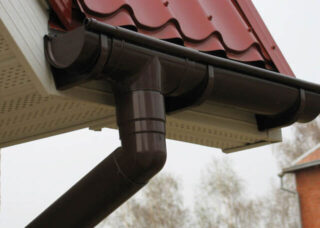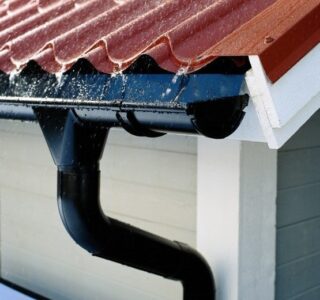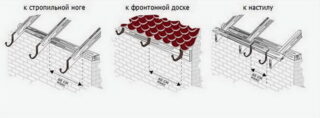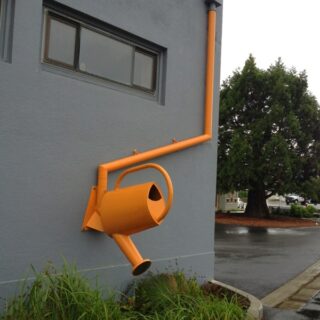The main reason for roof leakage is not improper roofing or rafter construction, but water retention. Only at a very large angle of inclination, rainwater or even snow does not remain on the roof. In all other cases, in order to drain water, it is necessary to install a drainage system for metal tiles, profiled sheets, slate.
What is a gutter for and what does it look like

Runoff of water on the roof is a variant of natural drainage. However, in places with a more pronounced relief, at the inner corners, complex cornices, this is not enough. Water and snow accumulate here, which is fraught with leakage or damage to the roofing material.
A drain is a type of authorized drainage system. Such a device is installed in difficult areas, collects water and brings it out of the roof.
The drainage system includes several elements:
- sub-eaves gutter - a structure that collects water from the roof;
- funnel - water is removed through this device;
- pipe - drainage of water beyond the boundaries of not only the roof, but also the building.
Gutters and funnels can have different shapes depending on the purpose.
Construction of gutters

Before fixing the east to the roof under the tiles or corrugated board, you need to choose the right device.
According to their shape, gutters are distinguished semicircular, rectangular, square. Round ones are most often used, since they remove the maximum volume of water at the smallest size. In addition, such a section prevents the appearance of turbulence, which means that dirt does not accumulate on the walls and in the places of transition into a funnel or pipe.
By design, a distinction is made between closed and open gutters.
- Closed - the funnel is one whole with the drain. This design is easier to install and looks elegant. However, the hole for the funnel is narrow here, it needs to be freed from fallen leaves, dirt, ice.
- Open - the funnel acts as a separate element and is mounted independently. The permeability of such a system is higher, but the windage is also higher. Therefore, such structures must be carefully attached.
Gutters and funnels are made from different materials. The main requirement for them is corrosion resistance.
- Plastic is a cheap, lightweight, unpretentious option. Plastic is not subject to any kind of corrosion, does not need maintenance. The material dampens the sound, so the noise of flowing water does not bother the inhabitants of the house. The disadvantage is low resistance to mechanical stress. Plastic gutters are quite easy to bend, crush, and a strong gust of wind can tear them off.
- Galvanized iron is a durable, strong, reliable material. It is not afraid of corrosion, as it is covered with a protective layer of zinc and polymer paint. The downside is high voicing, the noise of water is very well heard.
- Copper alloy - even more resistant to corrosion than galvanized steel, but not so bell: copper has a higher sound absorption coefficient. Copper gutters are very beautiful and do not lose their attractiveness after many years.
The color scheme of metal structures matches the shades of paint for profiled sheets and metal tiles. It is easier to match them by color.
How to fix gutters

To install the drain, use special fasteners - hooks or holders. This is a version of the clamp, which is a semicircle.The gutter is laid on the bracket, rests on it, so such a hook must be strong.
You can attach gutters to a metal roof using the following types of fasteners.
- Long - the hook is attached to a long bar. Such a model is fixed on the rafters, a solid crate. Installation is carried out up to the roof deck. You can fix the hooks to the curtain board.
- Short - The base is short. Usually they are installed after laying the flooring and attached to the frontal board, which is placed on the ends of the rafter legs.
- Universal - modular design with removable mounting plate. If you install the latter, you get a long fastener, if not, a short one.
There are also short models available in which the angle of the mounting base is adjustable. Such fasteners are required, for example, when the system is fixed to an inclined frontal board.
In the manufacture of gutters, pipes with a wall thickness of 3-4 mm are used. This is enough to withstand the pressure of rainwater. The standard section of a semicircular gutter is 63, 90, 110 mm.
The size of the fasteners is also chosen for the size of the pipes - 75, 100, 125, 150 mm.
The dimensions of the drain are calculated taking into account the roof area, the amount of precipitation, the slope of the roof and the number of collection points.
How to properly fix the gutter yourself
- Fastening to rafters is a typical option. For this method, hooks with a long mounting plate are used. It is fixed on the rafter leg with a self-tapping screw. The position is chosen so that the drain is under the edge of the overhang. Installation is carried out up to the roof deck.
- The gutter can be mounted on the frontal board both before and after the flooring. You can put both long and short fasteners on the board. The latter is easier to handle. If the frontal bar is placed at an angle, take brackets with a position adjuster.
- "Crutches" as a basis - this option is used if there is no frontal board, but it is impossible to fix it on the crate for some reason. Then metal or wooden "crutches" are attached directly to the wall, and the drain is installed on them and fixed with pins. This method is more often used on outbuildings, since the gutter is not very aesthetic.
- Fastening along the edge of the slab is possible if the roof is covered with a rigid material, such as ceramic tiles, tesa. In this way, plastic gutters are placed, since they are much lighter. Special type of hooks are used, which are placed on the clamps.
- You can also correctly mount the drainage system under the profiled sheet or metal tile using invisible brackets. They do not hold the gutter from below, but from above. The fasteners are placed with a smaller step - 40–70 cm. When installing on the rafter leg from above, the holder must be bent.
- Pull-up attachment - located inside the gutter itself. The drain is fixed to the bracket using bends on the hook itself. The bracket has a female threaded bushing. Through it, both structures are screwed to the wall. Thus, you can put the gutter on the frontal board and on the rafters.
Almost any installation method can be performed using universal fasteners - with a removable L-shaped mounting plate.
How to fix modern plastic gutters

It is not difficult to fix the drain with your own hands. The instruction is simple.
- On the board to which the gutter will be attached, mark its position - in height. Then it is taken into account that the gutter must be mounted with a slope of 3-5 mm for each running meter and the mark is corrected.
- Mark the location of the hooks. The step between them is determined by the type and size of the drain. It is recommended that the hooks be numbered.
- The edges of the brackets are folded with a strip fold.
- First, install the 2 extreme hooks. A cord is pulled between them and the rest of the holders are fixed according to its level according to the marks.
- Determine the location of the funnel and cut a 45 mm edge for it.
- Then the drain itself is collected: a gutter, a funnel, a pipe are laid.
The installation scheme for a metal gutter system is no different. However, this model is heavier. It is better to fix it on the crate, wall, frontal board, and not on the roof. The step between the holders is smaller here.
How to install a heating cable in the drain
To prevent the water in the drain from freezing in winter, the system is equipped with a heating cable. This is just one element of the overall heating system. The work is carried out in a complex manner, together with the installation of the cable along the edge of the slope, in the drainpipes.
Mount the heating wire directly in the gutter. It is recommended to cut the cable and connect with couplings in places of rotation at an angle. Inside the gutter, the wire is fixed across with a special mounting tape.
The fixing step depends on the nature of the cable. Resistive is fixed every 25 cm, self-adjusting - every 50 cm. Heat-shrinkable tubing can be used for fastening. The attachment points are sealed.









